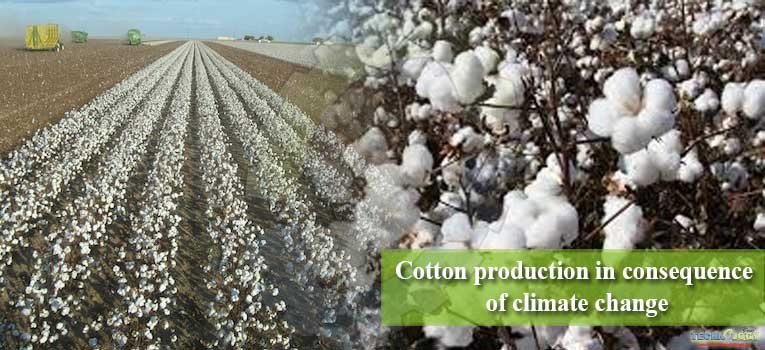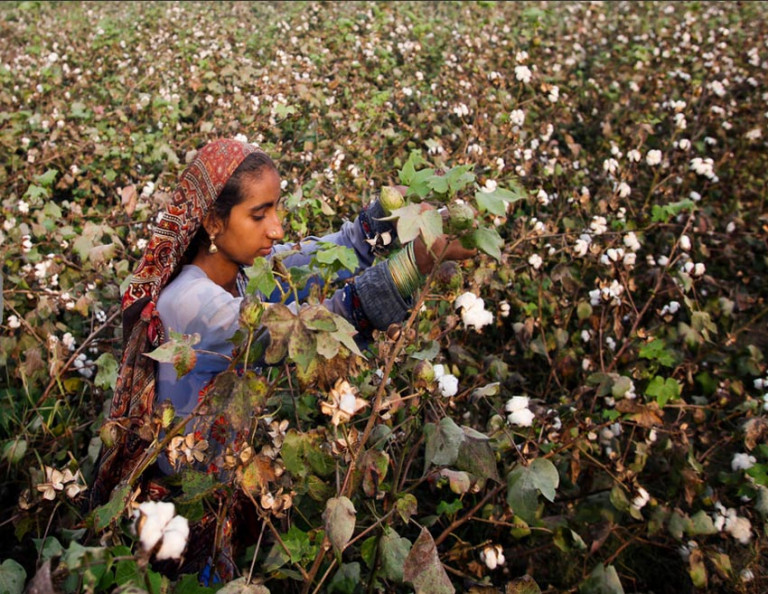Cotton crop plays an imperative role in Pakistan’s frugality. Pakistan ranks 4th in the world with respect to cotton production. In Pakistan cotton production is fundamental to the commercial advancement of the country.
 Almost large number of people is reliant on the cotton industry and its associated textile sector, and principal status is given to the crop in the country. Pakistan’s cotton and the related textile products are permissible on the national and international level for its high quality.
Almost large number of people is reliant on the cotton industry and its associated textile sector, and principal status is given to the crop in the country. Pakistan’s cotton and the related textile products are permissible on the national and international level for its high quality.
Cotton plant is found to be sensitive to changing climate at developmental and fruiting stage. Increasing temperatures, drought, restricted freshwater and irregular rain patterns are expected to amend cotton plant’s ability to grow and produce. As time and behavior of precipitation is changing because of climate change so water resources are diminishing continuously in Pakistan.
According to recent research because of climate change in Pakistan duration of summer is also increasing however, water resources is draining out and rainfall pattern is also shifting rapidly. Pakistan’s agricultural experts and scientists have to amplify the research activities for making best policies to increase cotton production in the consequence of climate change.
It is the matter of appreciation that agricultural experts have developed cotton varieties which gives more yield even at high temperature and water limited conditions and tolerant to immediate weather fluctuations such as cotton BT variety FH-326. To overcome the consequences of climate change modern techniques of irrigation is introducing in the country to avoid water loses and to gain maximum yield with less water.
There are some suggestions which if followed, cotton per acre yield can be increased in the changing climate scenario;
- Before the sowing of cotton ginning waste have to be removed and demolished in order to avoid white fly and pink bollworm attack in the next cotton season. Pink bollworm attacks on flower, developing bolls and eats both male and female part of flower. Due to attack of pink bollworm weak and colorless lint is obtained which is nonpaying in the market.
- In the recent few years intensity and duration of heat has increased. Sometimes in April-May temperature has increased upto 47oC which desperately affect the growth of cotton plant and the main cause behind dropping of flowers and bolls is high temperature. Drill sown cotton is severely affected by heat wave. To avoid intense heat and to make soil cool cotton should be sown after dual Rouni so it’s not only improve germination but prevent from wilting and dying of plants also.
- To minimize the consequences of changing climate, cotton should be planted on beds because in bed sowing irrigation is applied at the time of sowing so the germination and mortality rate of plants is generally less than other methods. We can save not only water and seed but maintain plant to plant and row to row distance also. In bed sowing it’s easy to accomplish insects, diseases and weeds because spray application is easier in this method.
- Due to increased temperature and limited rainfall in changing climate not only dropping of flowers and developing bolls increased but size of boll and duration of boll formation is also increased so in such situations it is recommended to increase plant to plant distance depending upon growth pattern and variety of crop being sown. Grow crops which requires less duration to complete life cycle and tolerant to high temperature.
- By eradication of weeds before flowering of plants yield can be increased. Itsit, dheela, baru, khabbal and swanki are major weeds of cotton crop but now in the scenario of changing climate new weeds are introduced such as makru, hulhil and gajarbooti which posed a serious threat to cotton crop. To kill such type of weeds new chemistry herbicides should be used recommended by agricultural experts.
- To combat weather fluctuations it is better to grow more than one type of cotton for example instead of growing BT cotton, at 10% area non-BT variety should also be planted.
- Use 6-10 kg seed per acre for bed sowing and 8-12 kg seed per acre for drill sowing to attain required number of plants per acre for better and lucrative yield.
- Before sowing, seed should be treated with fungicide recommended by agricultural experts to avoid sucking insects such as white fly for one month so healthier plants will produce at the initial stages which enables plants to survive even in the harsh conditions of changing climate.
In weather fluctuations better care and immediate decisions to solve specific problem is very important. Best Fertilizers choice, quantity and time of application, time and quantity of irrigation water, avoid wastage of fertilizers and water, prevention from damaging insects are the basic principles which proved to be a helpful to minimize the impacts of climatic variations. Changing sowing time of cotton may also be the fruitful act to overcome the hazards of climate change.
Alleviation and adaptation to climate change in cotton production should be oriented towards the amalgamation of, and renovation to, healthier; natural production and management practices that are less depending on inorganic products and use shrinking irrigation water efficiently, and count on reduced tillage for soil protection.
Author: Muhammad Rehan Saleem, Zain Ul Abidin, Muhammad Shafique, Zubair Majeed


